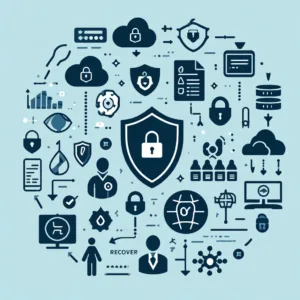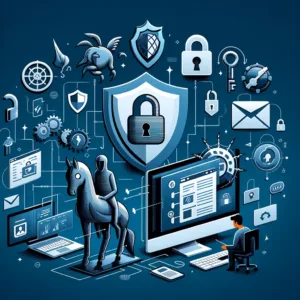What is Cybersecurity?
In this Article
What is Cybersecurity?
What is cybersecurity? Cybersecurity involves protecting computers, servers, mobile devices, electronic systems, networks, and data against harmful attacks. It is also referred to as information technology security or electronic information security.

The concept of what is cybersecurity is relevant in several settings, including business environments and mobile computing, and encompasses several key areas:
- Network Security: This is about safeguarding computer networks from intruders, including both targeted hackers and general malware.
- Application Security: This aims to ensure that software and devices remain secure from threats. A vulnerable application might expose the data it is meant to protect. Effective security starts during the design phase, long before the software or device is operational.
- Information Security: This secures the integrity and confidentiality of data, both when it is stored and when it is being transmitted.
- Operational Security: This covers the procedures and decisions involved in managing and guarding data assets. It includes determining user permissions for network access and the protocols for data storage and sharing.
- Disaster Recovery and Business Continuity: Integral to understanding what is cybersecurity, these protocols determine how an organization will respond to a cybersecurity event or any other disruption that affects data or operations. Disaster recovery plans outline how to restore operations and data to pre-disruption levels. Business continuity plans describe how the organization will continue operating despite certain losses, showcasing the resilience aspect of cybersecurity.
- End-User Education: This targets the most variable element of what is cybersecurity: human behavior. Educating users on secure practices—like not opening dubious email attachments, avoiding unknown USB drives, and other safety measures—is crucial for maintaining organizational security.
Cyber Threat Magnitude
The threat from cyberattacks is escalating globally at a swift pace, underscoring the critical question of what is cybersecurity and why it’s essential. With the number of data breaches increasing each year, a study by RiskBased Security reported that an alarming 7.9 billion records were compromised in just the first nine months of 2019. This is over twice (112%) the number of records breached during the same timeframe in 2018.
The sectors most affected include medical services, retail businesses, and public agencies, with the majority of breaches perpetrated by malicious actors. These sectors are particularly targeted by cybercriminals due to their storage of financial and medical information. However, any business utilizing network systems can become a target for customer data theft, corporate spying, or direct attacks on customers.
As the threat environment expands, so does global investment in cybersecurity measures. Analysts at Gartner anticipate that cybersecurity spending will rise to $188.3 billion in 2023 and exceed $260 billion by 2026. Governments worldwide are addressing these security challenges by issuing guidelines to help organizations enhance their cybersecurity protocols.
In the United States, the National Institute of Standards and Technology (NIST) has developed a cybersecurity framework to help mitigate the spread of malicious software and enhance early detection through ongoing, real-time monitoring of all electronic resources.
The significance of consistent system monitoring is also highlighted in the U.K. government’s National Cyber Security Centre’s ’10 steps to cyber security,’ which is a part of understanding what is cybersecurity. Similarly, the Australian Cyber Security Centre (ACSC) frequently issues advice on how organizations can defend against current cybersecurity threats, underscoring the dynamic nature of what is cybersecurity.
Types of Cyber Threats in Cyber Security

Cyber threats manifest in three primary forms:
Cybercrime involves individuals or groups attacking systems for financial gain or to cause disruption.
Cyber-attack typically refers to politically motivated efforts to gather sensitive information.
Cyberterrorism aims to disrupt electronic systems, causing fear or panic.
How do cybercriminals gain control of computer systems? Here are several prevalent methods that threaten cybersecurity:
Malware (Malicious Software) This common threat involves software developed by cybercriminals to disrupt or damage a legitimate user’s computer. Often distributed through unsolicited email attachments or deceptive downloads, malware can be used for monetary gain or as part of politically charged cyber-attacks.
Types of malware include:
Virus: This malware type replicates itself and spreads by attaching to clean files, injecting them with malicious code.
Trojans: Disguised as legitimate software, Trojans deceive users into installing them, allowing them to cause harm or steal data.
Spyware: This secretly monitors user activity to collect information, such as credit card details.
Ransomware: This locks and threatens to delete a user’s data unless a ransom is paid.
Adware: Often used as a method to deliver malware through advertisements.
Botnets: Networks of infected computers used by cybercriminals to carry out tasks without the user’s knowledge.
SQL Injection This attack exploits vulnerabilities in data-driven applications, allowing cybercriminals to insert harmful SQL statements into a database and steal sensitive data.
Phishing Phishing involves sending emails that mimic legitimate companies to trick recipients into divulging personal information like credit card numbers.
Man-in-the-Middle Attack In this strategy, cybercriminals intercept communications between two parties to steal data, commonly occurring over unsecured WiFi networks.
Denial-of-Service Attack This attack floods systems, networks, or servers with traffic to overload resources and prevent the system from handling legitimate requests, rendering it inoperative and disrupting organizational operations.
Current Cyber Threats
What are the newest cyber threats in what is cybersecurity that individuals and organizations must watch out for? Recent alerts issued by the governments of the U.K., U.S., and Australia highlight several critical threats.

What are the newest cyber threats that individuals and organizations must watch out for, and how do they relate to what is cybersecurity? Recent alerts issued by the governments of the U.K., U.S., and Australia highlight several critical threats, emphasizing the ongoing importance of understanding cybersecurity.
Dridex Malware In December 2019, the U.S. Department of Justice took action against the leader of an organized cyber-criminal group linked to a widespread Dridex malware campaign. This malicious effort impacted public and government sectors, as well as global business and infrastructure networks.
Dridex, a financial trojan active since 2014, infiltrates systems via phishing emails or through existing malware. It is designed to steal passwords, banking details, and personal information, leading to fraudulent activities and substantial financial damages in the hundreds of millions.
In response, the U.K.’s National Cyber Security Centre has advised the public to keep devices patched, maintain active and updated antivirus software, and ensure regular backups of important files.
Romance Scams In February 2020, the FBI highlighted a rise in confidence fraud through online dating platforms. Cybercriminals exploit individuals seeking romantic connections, tricking them into revealing personal information.
The FBI noted that in 2019, 114 victims in New Mexico suffered financial losses totaling $1.6 million due to romance scams.
Emotet Malware Towards the end of 2019, the Australian Cyber Security Centre alerted national organizations about the Emotet malware, a global threat.
Emotet is an advanced trojan known for stealing data and loading additional malware. Its proliferation is aided by weak passwords, underscoring the need for robust password security to protect against such threats.
End-User Protection End-user or endpoint security is vital in what is cybersecurity. It typically begins with an individual inadvertently introducing malware to their device.
Cybersecurity measures, integral to understanding what is cybersecurity, protect systems by utilizing cryptographic protocols to encrypt data in emails and files, safeguarding them during transit and from theft. Security software scans for malicious code, isolates it, and then removes it. These programs also handle threats hidden in the primary boot record and can encrypt or erase data on the hard drive.
Real-time malware detection is crucial. Many security tools employ heuristic and behavioral analysis to monitor software behaviors and adapt to polymorphic and metamorphic malware that alters its code.
As cyber threats evolve, so do security programs, continuously developing new defenses. This adaptation is a fundamental aspect of what is cybersecurity. Effective use of these tools includes regular updates and educating users on maintaining security software, ensuring protection against emerging cyber threats.
Tips for Cyber Safety
How can businesses and individuals effectively protect themselves from cyber threats? Understanding what is cybersecurity is crucial in this context. Here are some essential cyber safety tips, along with a few additional recommendations to enhance your security:
Update Your Software and Operating System: Regular updates ensure you receive the latest security patches, helping to block new vulnerabilities.
Use Antivirus Software: Programs like Kaspersky Total Security can detect and eliminate threats. Continually update your antivirus software to maintain the highest level of protection.
Employ Strong Passwords: Create passwords that are complex and difficult to guess. Consider using a password manager to keep track of stronger, unique passwords for different accounts.
Be Cautious with Email Attachments: Avoid opening attachments from unknown sources as they may contain malware.
Avoid Suspicious Links: Do not click on links in emails from unknown senders or unfamiliar websites, as these are common methods for spreading malware.
Steer Clear of Unsecured WiFi Networks: Public WiFi networks can expose you to risks such as man-in-the-middle attacks. Use a virtual private network (VPN) if you need to access the internet on public WiFi.
Enable Multi-Factor Authentication (MFA): This adds an extra layer of security by requiring more than one form of verification to access accounts, significantly reducing the risk of unauthorized access.
Regularly Backup Important Data: Keep regular backups of critical data in separate locations, so you can restore information quickly if a cyberattack occurs.
Educate Yourself and Others: Stay informed about the latest phishing scams and cybersecurity trends. Educating employees and family members about recognizing and avoiding threats can greatly reduce vulnerability.
Secure Your Home Network: Change default router settings, use strong WiFi encryption, and regularly update router firmware to protect against potential intrusions.

